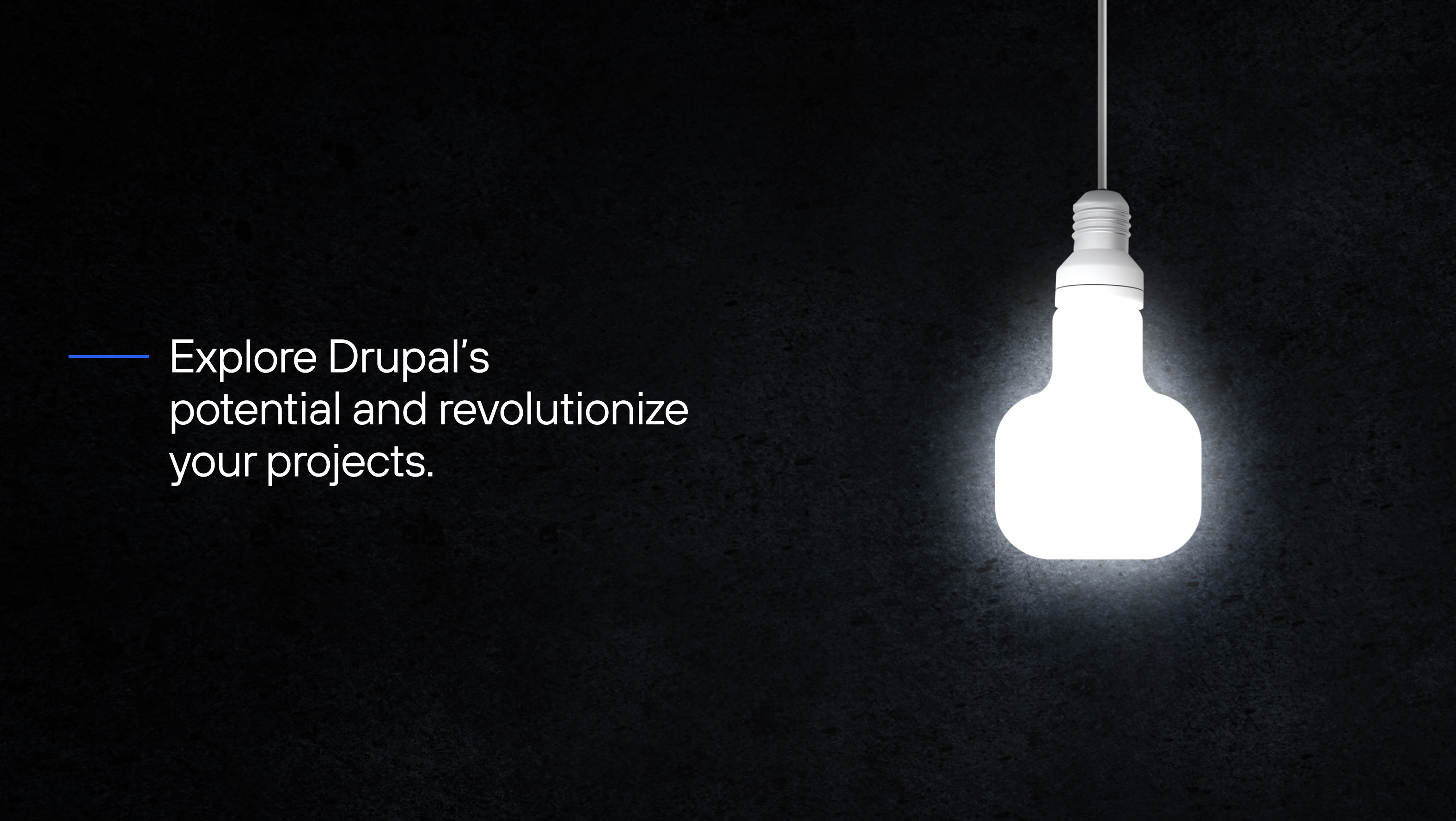
If you've ever heard of Drupal and wondered what it is and why it's one of the top choices for building robust, impactful, and accessible websites, this article is for you. Regardless of your business’s industry, companies seeking a CMS that combines flexibility, security, and scalability for ambitious projects need to understand the full potential of this tool. So, what is Drupal, exactly? Let's dive into the details.
It goes a step beyond the well-known content management systems. Drupal presents itself as a robust web development framework, ideal for organizations that require total control, data governance, and high customization, growth, and performance capacity.
To ensure clarity and help with your decision-making process, we've created this comprehensive and up-to-date guide. We invite you to explore the Drupal universe, from its origins and evolution to the recent innovations involving Artificial Intelligence, including its modular architecture, the strength of its global community, and real-world use cases.
Throughout the article, you’ll also get up to speed on the latest updates like Drupal Starshot and Experience Builder, solutions that are shaping the future of website creation. These tools empower technology and marketing teams to build competitive, innovative digital products that exceed the highest expectations. Still wondering what Drupal is and why so many organizations choose it?
I want to build a website with Drupal
What is Drupal?
Drupal is a content management system (CMS) and modular framework written in PHP, ideal for building secure, flexible, and scalable websites. It’s open-source and free, used by individuals and companies of all sizes worldwide to create, manage, and publish highly customized websites with complete control over their content.
Known for its robustness, Drupal supports everything from simple blogs to large, high-traffic platforms. It is backed by a vast community of developers who continuously contribute to its evolution. Its modular architecture, multilingual support, and advanced security features make it a solid choice for those looking for a complete and reliable site management solution.
Learn more: CMS: what it is, how it works, and which is the best choice for your business
The Drupal Timeline
Drupal was born in 2000 as an academic forum, created by visionary Dries Buytaert. Soon after, in 2001, it became an open-source project under the GPL license, marking the beginning of a remarkable journey of innovation and maturity in the CMS landscape.
Over the years, new versions of Drupal have been released, each one bringing significant advances that redefined the digital landscape and solidified Drupal’s presence in complex projects. This timeline shows how Drupal evolved, but what is Drupal at its core?
- 2000: Drupal is created as an academic forum.
- 2001: Launched as an open-source CMS (GPL license).
- 2005: Drupal 5 is released, introducing the Views module, which revolutionized the creation of dynamic content.
- 2011: Drupal 7 is launched with a more intuitive user experience.
- 2015: Evolution to Drupal 8, incorporating modern technologies like Symfony and Twig, support for REST APIs, and enhanced accessibility (WP-access), representing a major architectural leap.
- June 3, 2020: Drupal 9 is launched, focused on stability, compatibility, and ease of upgrades.
- December 14, 2022: Drupal 10 is released, focusing on performance, simplified development, and new integrations such as AI.
- August 2, 2024: Drupal 11 (latest version) is launched, with new features, performance improvements, enhancements to the Field interface, and updates to taxonomy terms.
This continuous evolution strengthens Drupal’s maturity and its potential to support a wide variety of projects. Its constant growth and relevance keep the platform competitive and a great CMS option.
End of Life for Drupal Versions
Staying aware of the end-of-life (EOL) for Drupal versions is essential to ensure the smooth operation and continuity of any digital project. When a version reaches EOL, it no longer receives security updates, bug fixes, or official support, making the site vulnerable to attacks and failures.
This directly affects compliance with legal requirements (such as LGPD/GDPR), project scalability, and compatibility with new technologies, APIs, and modules.
Therefore, migrating to the most current version is indispensable. Planning avoids emergency costs, service interruptions, and technical rework. Since each Drupal version has a defined lifecycle, understanding it enables proactive management of your digital infrastructure.
Currently, we are on Drupal 11, whose end-of-life is scheduled for 2027. The next version is set for release in 2026, reinforcing the importance of continuous planning to ensure updates and security.
Core vs. Modules: The Modular Architecture that Powers Everything
At its core, Drupal has a lean foundation that provides essential functions for any website. However, what truly sets it apart from other CMSs on the market is its unlimited ability to expand and customize, allowing each project to be built precisely to fit its needs.
This minimal base, which is just the starting point, includes features such as:
- user management;
- access control based on permissions;
- taxonomy systems (to organize content with categories and tags);
- dynamic menu management;
- and caching systems for performance optimization.
But Drupal’s true strength lies in its flexibility and customization, made possible through its modules. These additional software components allow you to extend Drupal’s functionality in unimaginable ways. Some examples include:
- advanced SEO optimization tools;
- custom form creation;
- integration with CRMs (Customer Relationship Management), ERPs (Enterprise Resource Planning), and full e-commerce solutions;
- complex workflow automations;
- and detailed reporting tools.
These are just a few of the more than 50,000 active modules available in the Drupal community. The CMS combines a lightweight foundation with an expansive ecosystem, enabling highly personalized solutions with exceptional exclusivity, security, and performance.
Explore some of these modules and their functionalities.
Creating Visual Experiences with Drupal
Once your site’s functionality is defined through modules, the next step is shaping the visual and interactive experience for your users. That’s where themes come into play; they define the look and usability of your website.
Themes are sets of files that determine the visual appearance and interface of the site, including colors, fonts, layout, and graphical elements. They control how content is displayed to visitors and allow you to customize the site’s design without altering its core functionality, giving each project a unique identity tailored to its audience.
Themes also ensure the site is visually appealing and responsive, working seamlessly across all devices, from desktop to smartphone.
Built on Twig, a modern templating engine that separates logic from design, themes like Olivero (for the public interface) and Claro (for the admin interface) provide flexible maintenance, a modern aesthetic, and a secure foundation. With these tools, development teams can create interfaces that reflect brand identity, adapt across channels, and uphold both accessibility and performance.
The result? A design that’s consistent, functional, and enhances the entire user experience.
How Drupal Promotes Accessibility
Beyond delivering a strong core, flexible modules, and customizable themes, Drupal also guarantees digital inclusion and compliance with data protection laws. It places the user at the center of digital decisions, recognizing that everyone, regardless of ability, deserves a complete and respectful experience.
From the ground up, Drupal has been committed to inclusion. The platform adheres to international standards such as WCAG 2.1 (Web Content Accessibility Guidelines) and ATAG (Authoring Tool Accessibility Guidelines). Its default themes are built with careful attention to contrast, keyboard navigation, semantic markup, responsiveness, and screen reader compatibility.
Additionally, the Drupal community works tirelessly to ensure that modules and features follow best practices for accessibility at all levels, from interface to content. It’s a collective effort that benefits both users and organizations.
By adopting Drupal, your company operates within an ecosystem aligned with principles of accessibility, innovation, and social responsibility. This choice reflects a commitment to legal compliance and contributes to more human, inclusive, and sustainable digital experiences.
Deep dive: Digital Accessibility: Inclusive Experiences for All
Drupal as a Strategic Choice
Now that you better understand what Drupal is, the natural question is: why choose this platform for your business site? The answer lies in its powerful combination of unlimited flexibility, robust security, and proven scalability.
Drupal delivers confidently for a wide range of complex and mission-critical projects. It’s an excellent choice for:
- robust institutional portals;
- highly functional corporate intranets that enhance internal communication;
- advanced multilingual systems for global audiences;
- and collaborative knowledge platforms.
Its architecture excels at managing complex integrations between CRMs and ERPs, supporting multi-level editorial workflows with sophisticated approval processes, and allowing precise audience segmentation. Additionally, its robust tools empower marketing and digital operations to focus on high performance and resilience, ensuring your site grows sustainably with your business’s most demanding needs.
I want to build my site with Drupal
Key Features of Drupal
Now that you understand Drupal’s unique value proposition, let’s explore the features that make it the superior choice for high-complexity projects, each one clearly explained below:
| Feature | Practical Description | Competitive Advantage |
|---|---|---|
| Open Source | Free software with no licensing fees. Source code is open and maintained by a global community. | Customization freedom, cost reduction, and vendor independence. |
| Modular Architecture | Lightweight core with added functionalities via modules. | Extreme flexibility: use only what you need and avoid unnecessary features that could impact performance. |
| Robust Security | Dedicated teams monitor vulnerabilities. Security updates are frequent and well-documented. | Trusted by governments and corporations for handling sensitive data. |
| Responsive Design | Offers customizable themes that adapt to all devices (desktop, tablet, smartphone). | Consistent, optimized user experience, essential for SEO and accessibility. |
| Modern APIs (REST, GraphQL) | Native APIs for easy integration with mobile apps, ERPs, CRMs, and legacy systems. | Build omnichannel and headless solutions without restructuring the entire site. |
| Native Multilingual Support | Advanced support for multilingual websites without the need for external plugins. | Ideal for global companies and international institutional projects. |
| High Performance | Supports caching techniques like BigPipe and easy CDN integration. | Fast websites, even under heavy traffic, better SEO, and user experience. |
| Advanced Editorial Control | Custom workflows, permission management, and revision control. | Enables content teams to work independently and safely, vital for large organizations. |
| Accessibility | Strict accessibility standards (WCAG) are applied natively. | Ensures digital inclusion and legal compliance in many markets. |
| Integrated SEO | Features like clean URLs, custom meta tags, and granular control over site structure. | Improved search engine rankings without complex plugins. |
| Proven Scalability | Supports everything from small sites to massive corporate and government portals. | A solution that grows with your business, with no need to migrate to another platform. |
| Active, Vibrant Community | One of the largest open-source communities in the world with frequent events, active forums, and rich docs. | Constant platform evolution and collaborative support for any challenge. |
How It Works and Practical Uses
With all these features in mind, it becomes easier to visualize how Drupal operates in real life. It’s designed to manage information in a structured, efficient way, optimizing content workflows and enabling the development of complex, high-performance digital solutions.
Centered on entities (like articles, pages, products, and user profiles) and custom fields, Drupal organizes content in a flexible way that adapts to the specific needs of each project. This allows for dynamic admin interfaces tailored to various user types and complex editorial workflows.
Here are a few real-world use cases that illustrate its versatility and prominence:
- Government Websites: Many government agencies worldwide rely on Drupal for their public portals. The Drop Times highlights its use in European Commission sites and the Australian and Canadian governments.
- Universities and Educational Institutions: Leading global universities like Yale use Drupal for their academic portals, enrollment systems, research platforms, and labs. In Brazil, numerous federal and state universities also adopt Drupal to manage complex content and interactions with students and faculty.
- Internal Portals and Corporate Intranets: Large corporations, including Fortune 500 companies like Pfizer and NASA, use Drupal to build internal portals and intranets that automate editorial workflows, enhance internal communication, and integrate seamlessly with ERPs, optimizing operations and ensuring information governance.

The Heart and Driving Force of the Platform
These successful use cases are largely possible thanks to the support and dedication of a vibrant global community. The Drupal community is undoubtedly one of its greatest and most dynamic assets, serving as the engine behind the platform. It’s much more than a group of developers: it’s a collaborative, diverse ecosystem.
This community is made up of a vast global network of developers, designers, system architects, translators, accessibility experts, digital marketers, journalists, and enthusiastic users. Together, they contribute tirelessly to improving the platform.
Drupal Benefits for Specific Areas
This unwavering community support translates into real benefits for different departments within an organization. Each area can leverage Drupal to optimize its operations:
- Marketing gains a powerful tool to create and optimize high-conversion landing pages, rapidly update campaigns, and adjust SEO, all without relying on the IT team.
- IT: Sees Drupal as a platform with high-level governance, data standardization, simplified integration with legacy systems, and strong, transparent auditing and compliance processes.
- Developers benefit from well-structured APIs, a culture of automated testing that ensures code quality, modern development standards, and a high level of code reuse, drastically reducing development time and boosting efficiency.
- CMOs (Chief Marketing Officers): Get centralized reporting for a 360º view of digital performance, seamless CRM/ERP integration, and marketing automation tools, supporting strategic and integrated decision-making.
- CIOs (Chief Information Officers): Gain full control over critical data, top-tier security, business scalability, and multichannel governance with strong resilience.
A powerful quote from Luiz Petri, Drupal expert at Dexa:
"Drupal wasn’t made to cover the basics; it was built to solve complex problems in an elegant, secure, and scalable way. Choosing Drupal is thinking big."
What Are the Challenges and How to Maximize Drupal’s Potential?
Despite being an incredibly powerful platform with undeniable strategic value, it’s important to recognize the challenges Drupal may present. Like any cutting-edge technology, it has specific requirements that demand careful planning to fully unlock its potential, without underestimating its capabilities.
One key consideration is the learning curve: Drupal requires a qualified team with experience in both development and maintenance due to its technical complexity and depth of features. Platform updates, though essential for security and performance, require strategic planning and careful compatibility checks for custom modules and themes, which can affect project timelines. Deep customizations (often needed in highly specific projects) may also increase costs and deadlines.
Lastly, for Drupal to reach its full potential, it must run on a well-configured infrastructure, including CDNs, advanced caching systems, and load balancing. Without this optimization, Drupal’s performance may be underused, and its full value left untapped.
Overcoming these challenges, however, is an investment that results in a highly robust digital platform with outstanding growth capacity.

The Future of Drupal
Before closing this article, we must talk about new features like Drupal Starshot and Experience Builder, which incorporate the power of artificial intelligence. These initiatives aim to make Drupal even more accessible and powerful for building top-tier digital experiences.
Drupal Starshot
This is the next major revolution, designed to simplify and accelerate Drupal site creation by offering a complete, intuitive, out-of-the-box experience. Just as WordPress revolutionized blogging, Starshot seeks to revolutionize the creation of complex corporate websites with a pre-configured set of essential features and an optimized user interface, reducing initial complexity and launch time.
That means, even with the power to handle massive projects, Drupal’s learning curve will become easier to overcome.
Drupal Experience Builder
An innovative tool for designers and marketers, it enables the creation of complex layouts and visual experiences through a more intuitive, no-code interface. It promises advanced drag-and-drop functionality and granular control over content presentation, accelerating design and prototyping workflows.
Meanwhile, Drupal 10 significantly expanded its integration with AI, paving the way for transformative capabilities. Now it’s possible to use natural language APIs for:
- automatic content generation;
- smart metadata that boosts SEO without manual effort;
- and automatic user experience personalization, delivering tailored content to each visitor.
Read more: Experience Builder: The Power of No-Code for Digital Experience Creation
Drupal in Perspective
To truly grasp Drupal’s depth and market position, it helps to compare it to other popular platforms. Each CMS (or web development framework) has its niche and strengths, and Drupal stands out in a highly specific but critical segment of the digital landscape.
While platforms like WordPress are great for small to medium blogs and institutional websites, thanks to ease of use and a massive plugin ecosystem, Drupal excels in projects requiring complex architecture, advanced permission control, custom editorial workflows, and robust corporate integrations.
Joomla, although also open source, does not offer the same depth or granular control as Drupal, especially when it comes to scalable enterprise applications.
Comparing Drupal with pure development frameworks like Laravel or Symfony, the difference lies in focus. While those frameworks offer total freedom (requiring full development of every component), Drupal delivers a solid core with advanced content management, enterprise-grade security, and a vast modular ecosystem, saving time and resources on multi-departmental digital projects. If you're trying to understand what is Drupal in today’s digital ecosystem, here’s the answer.
In summary, if you’re searching for the best answer to what Drupal is, think of it as a powerful foundation for complex digital experiences, built on pillars of content governance, enterprise integration, and scalability.
Keep learning: Drupal vs WordPress: a strategic comparison
Choosing Drupal should be a strategic decision: it’s not the simplest CMS, nor the most widely used by volume, but it is unquestionably the platform of choice for companies, governments, and institutions that demand high performance, security, and flexibility in mission-critical digital environments.
